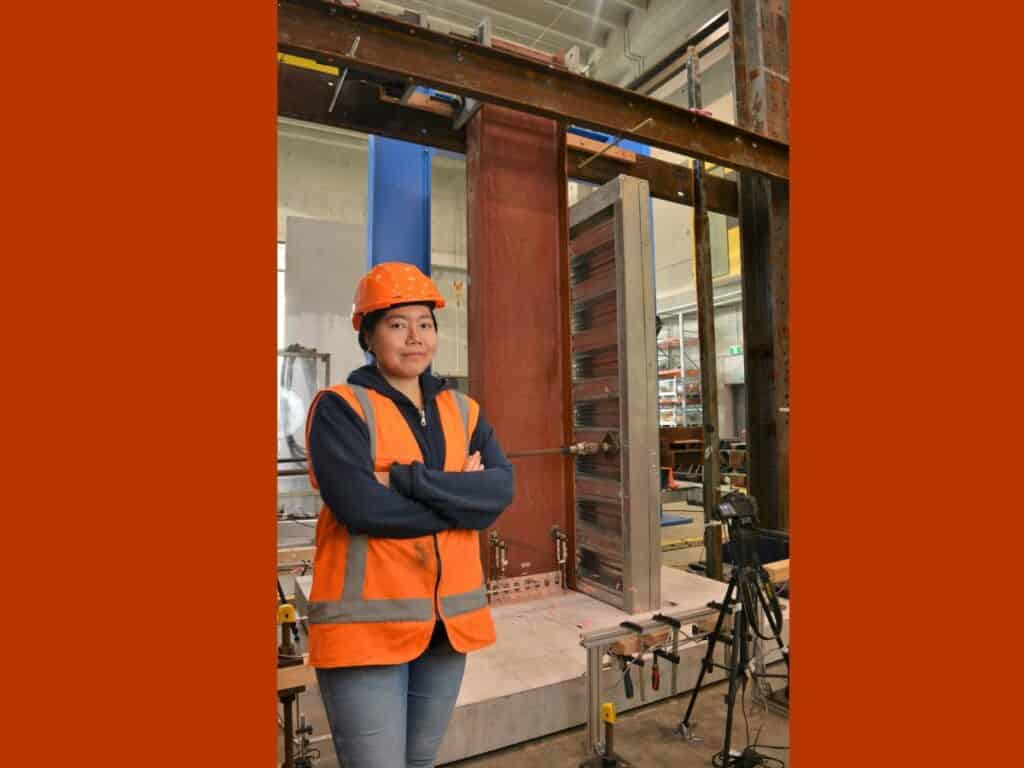Claire Pascua has a knack for making connections. She was drawn to her PhD topic – investigating connections between concrete walls and steel frames – because it looked challenging. And, sure enough, the interactions between these two common engineering materials have kept her busy over the last few years.
Her research stems from the increasing construction of hybrid buildings – those that use several materials in their structure. Typically, structural systems comprise a single material, such as concrete, steel, or timber. However, combining concrete walls and steel frames creates an efficient and economical system, allowing smaller members, shorter floor heights, built-in fire protection, and faster construction time.
Aotearoa New Zealand has separate design standards for concrete buildings and steel buildings but no explicit guidelines for combining the two. There is little research on how concrete walls and steel frames interact when used together, especially during earthquakes.
At the University of Auckland Structural Testing Laboratory, Claire conducted a series of tests on four full-scale concrete wall-to-steel beam connections, incorporating design practices by New Zealand engineers. She added floor slabs to her specimens – something not commonly done in previous studies – and subjected them to seismic and gravity loading.
Contrary to design assumptions, Claire’s specimens failed suddenly in a brittle manner by concrete breakout, demonstrating that the design needs improvements. Claire also tested some design variations and found that slotted holes in the web plate and a different anchorage system made improvements but still failed in a brittle manner. She is currently conducting numerical modelling to see how these connections impact the performance of a whole building.
While Claire believes that combining concrete walls and steel frames is a promising building solution, it is crucial to get the connections to behave as intended. With her supervisors, she aims to develop design guidelines to help engineers make better connections. “Imagine if we could live in buildings that wouldn’t be damaged in earthquakes: that is the future I want to see.”
Claire has enjoyed bridging the gap not only between hybrid connections but also between her supervisors. Her main supervisor, Rick Henry, specialises in concrete, while her co-supervisor, Charlotte Toma, specialises in structural design, and she gets advice on steel from Charles Clifton. She has found it valuable navigating different ways of thinking in various areas of expertise.
Claire enjoys the challenges of academia, “I really like that brief moment when I’m the only one who knows something”. Yet, she is also enthusiastic about sharing her research—having joined and occasionally won science communication competitions such as the Three Minute Thesis and QuakeCoRE Lightning Talks.
The other kind of connection Claire likes making is with people. Coming from the Philippines, she enjoys the lack of hierarchy in New Zealand and appreciates how Te Hiranga Rū QuakeCoRE supports student involvement. She found it fascinating that QuakeCoRE actively promotes different institutions and disciplines working together. And now, having been involved with QuakeCoRE throughout her PhD, she feels like she has valuable connections all over the country.

